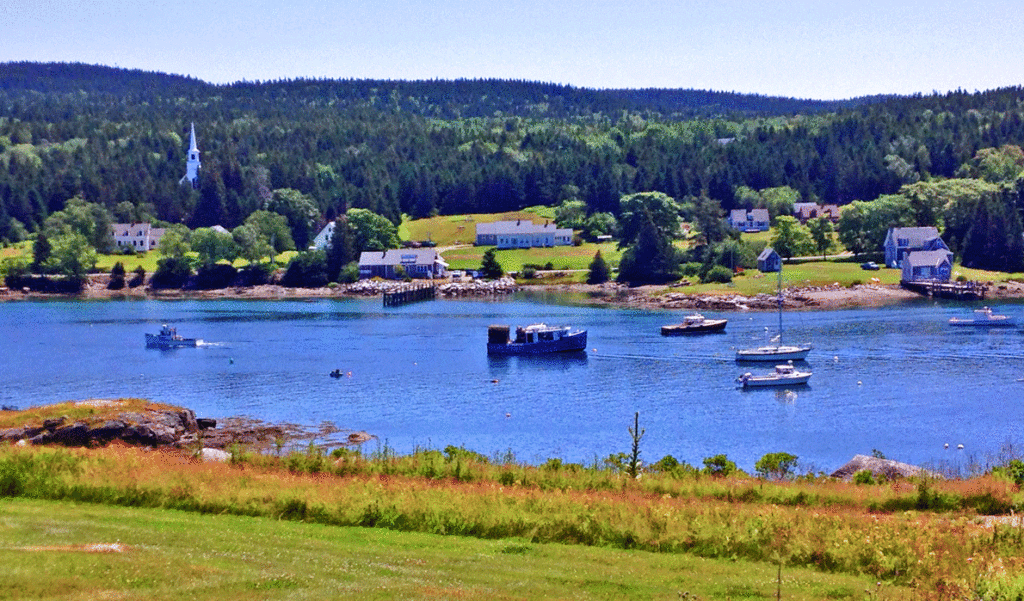By Bob Gerber
Isle au Haut’s Union Congregational Church occupies a prominent hilltop overlooking the thoroughfare between Kimball Island and the village at the island’s north end.
It was built in 1857 at a cost of $1,649 during a period of fervent evangelistic efforts to bring organized religion to island community life. In fact, the church was originally called the Evangelical Church of Isle au Haut. At that time, the island’s population, with the smaller surrounding islands, was about 230. Today, the year-round population is about 45, with only a few of the year-rounders attending church when services are provided.
Though founded, built, and sustained by year-round islanders for most of its history, since the 1940s—year-round services were held from 1913 to 1926—the church has been supported primarily by contributions from summer residents and visitors.
Church services are provided during the summer months, and most of the ministers have been young, many seminary students learning their trade. Some were well-seasoned pastors enjoying a summer working vacation in a beautiful place.
In 1915, Isle au Haut benefactor Ernest Bowditch had a substantial house designed by a Boston architect and builton the thoroughfare facing Kimball Island, and gave it to the church to serve as its parsonage. Dr. Frank Snell, the full-time pastor at the time, also provided medical and dental services out of the parsonage. In 1915, residents voted to exempt the house and property from taxes “as long as same is occupied by Rev. Dr. Snell.”
The Maine Seacoast Mission also has played a large role in island life, providing some winter services throughout the years and paying regular visits to the island. Like the church, it provides services beyond religious guidance. In recent times it provides telemedicine services on board the Sunbeam at the public landing.
TED’S SERVICE
I became a summer resident of Isle au Haut in 2005. At that time, and for a number of years prior, Theodore “Ted” Hoskins provided pastoral services to the church. Ted’s father had also been a summer minister on the island and Ted knew the island’s history and folklore.
Ted was well-liked by all and was consistently elected as moderator of the town meeting. When there was trouble on the island, if anyone could fix it, it was Ted. Summer services, particularly during August, were well-attended during his time as pastor. The services were the social event of the week where people who came to the island for one or two weeks a year met and caught up with friends.
During my time on the island, and, I am sure for most of its history, the church liturgy has been traditional Congregationalist. I grew up with the same liturgy in the 1950s and 1960s in the Congregational Church in Freeport, so it is very comforting to me.
The church is beautiful, a classic New England Protestant-denomination church with stained-glass windows at each end, and clear glass windows in the side walls. So what is wrong with this picture?
The church is supported primarily by older people. The younger, actively earninggeneration has not, for the most part, grown up with religious indoctrination or “the church habit.”
Thecongregation is dwindling and the church usually spends more than it takes in annually. Unless substantial increases in donations or decreases in expense occur, it will run out of resourcesin a decade or so. Its annual budget (not including major infrequent maintenance such as the repainting being done this summer) is about $17,000 a year, whereas income is $12,000 to $14,000 a year. What to do in the mean time?
From its beginnings, the church has had a significant role in community life. It has quietly provided financial assistance to those suffering hard times. It provides graveyard burial space and a designated memorial garden for scattering ashes. It is available for weddings and memorial services. Once each summer the church holds an evening lecture or music event, by old-fashioned kerosene lamp chandelier.
POWER TO THE ISLAND
In the 1980s, the island formed its own power company and anyone wanting service had to ante up an initial subscription payment. A substantial financial gift was given to the church which, in turn, loaned the money (at no interest) to many islanders to help them get electrical service. All those loans have beenfaithfully paid back.
With that success under its belt, the church started a community development loan program that loaned a few hundred to a few thousand dollars to many year-rounders for things like vehicles, boat engines, lobster traps, etc. The largest loan was given to the Island Store Association, which at one point was close to going out of business itself.
The church benefitted from a one-time donation of over 100 acres of land on the southwest side of Long Pond. Several pieces of land were sold out of that gift in the early 2000s, and the proceeds used to makebadly needed major repairs to the church and parsonage. After a gift to the town of land at the south end of the pond, including the public swimming access “beach,” 90 acres running up the southwest half of the pond were placed in a conservation easement to fulfill the wishes of the land donor. This left 10 acres of land for future sale.
One of the island’s greatest needs is affordable housing for both year-round residents and seasonal workers. Instead of trying to sell the remaining church land to maximize income, the church contracted with a local year-round family to sell, on an installment basis, five acres at an affordable price. This transaction will eventually allow one more year-round family to live on the island. In time, the remaining five-acre lot canbe sold to another year-round family. These transactions give the church regular income while providing another source of year-round housing.
Three years afterthe retirement of Ted Hoskins, the church called Rev. Allen Myers of Brooklin to be its “permanent” pastor, the term chosen to undermine the perception of the church as a summer only project. Allen continues to lead worship servicesevery Sunday in July and August. He also has taken over moderating town meetings.
In addition, he comes to the island in the winter for “Tuesday’sTable,” a church-sponsored function in which islanders gather ontwo Tuesday evenings each month, November through April, to enjoya free dinnercooked by volunteers, socialize, and sometimes play cribbage.
Allen also provides pastoral care and presence to the island as needed. The church is trying to re-establish a year-round presence—not to proselytize, but to provide aid, comfort, and pastoral continuitytoboth summer and year-round members of the community.
Where will the church go from here? If Sunday worship services are no longer relevant to the community, what should the mission of the church be? The church building stands as an enduring symbol of community life (the fishing grounds northwest of Isle au Haut have always been known as “the church grounds” because the steeple is a visible sighting point), and an enduring symbol of the island’s spiritual vitality.
Church buildings, however redolent of island memory and community life, can only remain standing with regular maintenance—often at significant expense. Is the church a relic of earlier times, preserved nostalgically, or does it continue to have a subtle but indispensable function in community life?
In the marketplace of institutions and entertainments competing for everyone’s attention—a marketplace characterized by an increasing need for cash resources—can the church stake a claim for its relevance to modern island life?
Bob Gerber is a semi-retired environmental engineer and geologist who works from Isle au Haut in the summer and Cape Elizabeth in the winter. He has served as a church trustee for five years and has been its treasurer for four years.
Since this column was posted, Gerber has provided an update, and he reports:
“The church and parsonage trim were painted this summer at an approximate cost of $30,000 which the church took out of its “long-term savings account.” I have retired as trustee and treasurer. The church had a real estate appraisal done of the parsonage this summer which came in at $110,000 less than we have been assessed by the town. (Churches themselves, or “sanctuaries,” are exempt from town real estate taxes, but parsonages can be taxed, although town assessors must subtract $20,000 from the full assessed value.) The church trustees are in the beginning stages of considering whether keeping a large old waterfront parsonage makes sense when it is used only three months of the year. They could potentially sell the parsonage and build a much smaller energy-efficient one or a two-bedroom “parsonage” that could be rented out in the winter for other uses, such as Island Institute Fellows, etc., and they would still come out ahead with some money to put into savings.
“On Aug. 26, a large contingent of Cranberry Island historical society members came over to Isle au Haut on the Sunbeam and attended church and then went to a pot-luck luncheon at the town hall. It was a very successful event and plans are already in the works to do some similar exchange next year. I think there are enough common issues with island churches to justify the Island Institute organizing a meeting of island church officials sometime in the winter to share ideas on how to survive in these days of aging congregations.”





